If you aren’t familiar with the Essential Oil craze by now, it’s a sign that you might have been living in a cave the last few years. Essential oils are concentrated plant extracts that are made from steaming or pressing various parts of a plant to produce a fragrance, which can then be used for therapeutic purposes. They have become a major trend in recent years, as many people boast about their great health benefits. I personally used to roll my eyes and make fun of the hippies and “tree-hugger” types that made such claims. Then, eventually I became one of the hippies myself when I experienced all the ways they added value to our family. Now, when my husband makes fun of my oily obsession, I totally own it! 😉
Though I use them for so many different things, I have found them particularly helpful for my children’s special needs. In fact, I’ve even read studies that found a couple of them (such as copaiba) to be more effective than CBD oil or medical marijuana, but without the risk of the THC traces. Therefore, I’ve compiled a list of my favorites that I use specifically for special needs. Three of the diagnoses in our household include Autism, ADHD, and Anxiety, so these are the conditions of which I can speak with the most expertise. I may not be as familiar with other types of conditions, but there are still some common symptoms one might encounter across the board.
*Disclaimer: I am not a medical expert and the content contained in this article should not serve as medical advice. Essential oils are not used as a treatment or cure, but as general support to health. Please consult a licensed physician before trying essential oils and determining if they can benefit you or your family. **Affiliate Disclaimer: This post may include affiliate links where I get paid a commission for some recommendations. However, I only bring you resources that I have personally tried or researched, and firmly stand by them. As an Amazon Affiliate, I earn on qualifying purchases.
When shopping for the right essential oils, an important thing to keep in mind is the product quality. If you want to get your money’s worth, you are best to go with a brand you know and trust that has not diluted or added toxic ingredients to their oils. You can find them just about anywhere, including the grocery store, but my favorite brand of choice is the Young Living brand. I have researched different types of oils on the market and I trust the Young Living brand the most. They have a “seed to seal” policy and are known for preserving the purity of their oils. You will find that they are pricier than other brands, but you are paying for that extra assurance of quality. I am a member of Young Living and, therefore, I get my oils at a discounted price. If you are interested in a discount, as well, you can sign up here: Young Living Essential Oils. You are also free to shop or browse these oils without signing up for the membership as a guest.
If you are new to essential oils, it can be a little overwhelming to learn about all the oils out there and their various uses. In my research, I’d find that one oil could have a significant number of uses. Therefore, I’d get a little lost trying to match the right purpose with the right oil. To make things a little more clear cut for you, I’ve provided a matrix below, summarizing different oils and the benefits they can serve for certain special needs traits or challenges. I have included a somewhat comprehensive list in this matrix because there are so many ways that these oils can provide support and because everyone’s experience with them is unique. I will provide a little more detail, however, on my particular favorites in the sections to follow.
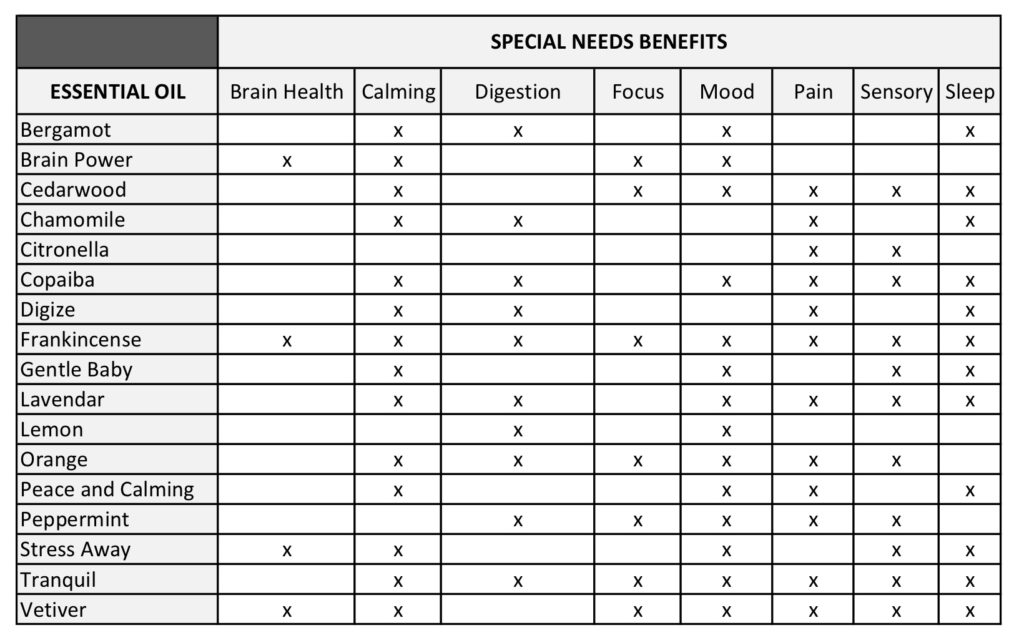
Essential Oils for Calming and Mood
There are some common challenges we face in our household, which include anxiety and hyperactivity. Sleep disruption is another problem we experience often, and it was especially an issue when our kids were younger. Special needs parents are often chronically sleep-deprived. Therefore, the most sought after essential oils are the ones that promote calming and restful properties. There are tons of oils that can help with calming and sleep, including lavendar, chamomile, cedarwood, copaiba, bergamot and frankincense. There are also some oil blends that Young Living carries that promote peace and calming. Blending single oils together can be beneficial and maximize the effectiveness of your health goals. The following blends are original to Young Living, specifically: “Stress Away,” “Peace and Calming,” “Tranquil,” and “Gentle Baby”. But, here are my tried and true favorites that I use daily for calming, mood and sleep:

- Lavendar– This is my number one! You could say lavendar was my “first.” It is my true love of all the oils. If I could only pick just one, it would be lavendar, hands down. This oil is useful for so many things. It’s like the Swiss-Army knife of all the oils. But, it’s probably best known for its calming effects. Many people use it as a sleep-aid or for a pleasant relaxing effect in the bath or spa. I pretty much emerse myself in it hourly. Not only do I diffuse it at night, I wear it as a lotion, diffuse it from my necklace, spray it on my pillow and clothes, diffuse it in my car, you name it. In fact, I may be slightly addicted. When I’ve gone too long without inhaling it, I’m really just not quite right! 😉 I love to diffuse it for my kids. A great time to run lavendar in the diffuser is towards evening when I need them to start winding down for the bath and bed routines. However, I also like to blend them with other oils for general calming during the day, especially if I’m finding my son a little overstimulated or hyperactive. It’s also helpful for both kids who experience bouts of anxiety, often due to the pressure of their schoolwork.
- Cedarwood– This is my number one oil for sleep. It truly acts like a sedative for me and my kids. Just 20 minutes in after running it in a diffuser and we are seriously OUT! I absolutely love it for insomnia and restlessness, because it encourages the body’s own natural release of melatonin. Everyone’s reaction and tolerance is different, but I would say this oil in particular puts me in such a deep dreamland state, it is hard to wake up the next morning. Have you ever experienced a Benadryl hangover? It’s almost the same effect on me. So, keep this in mind when using it on your kids. You may want to ease into it.
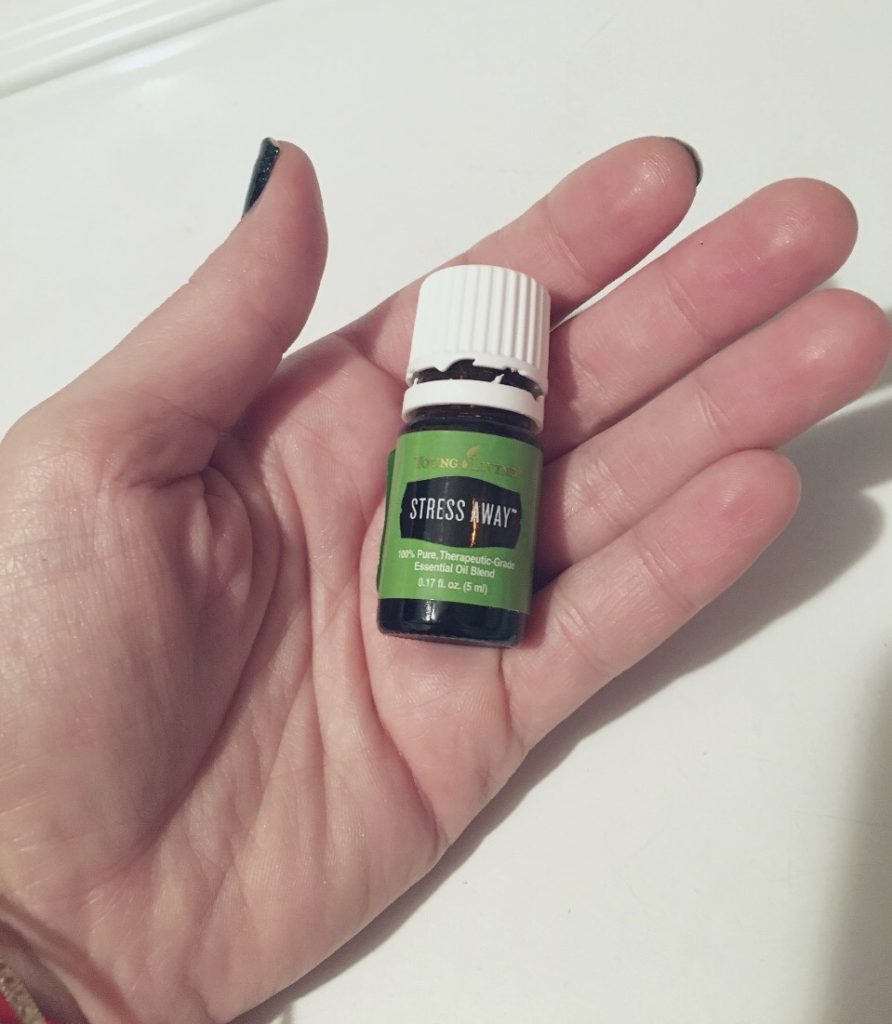
- Stress Away– I’m not going to lie. It took me a little while to get used to the smell of this one. It is a combination of lime, copaiba, cedarwood and others, all scents that take some getting used to. However, this little concoction is like my version of a pot brownie without the worries of the THC. Copaiba is especially helpful for calming and so many other powerful benefits, some of which I’ll discuss in other sections. Cedarwood, which I already mentioned above, is another favorite contained in this blend that enhances sleep. Sometimes I run these separately as singles, but the “Stress Away” blend helps me combine my favorites in one bottle. Now, I really enjoy the scent and truly do notice a reduction in my kids’ nervous tension when using it.
- Orange– Another oil that promotes calming while also acting as an anti-depressant. This is one of my favorites just for mood-lifting. It’s one of those very clean-smelling fragrances with a pleasant citrus-like scent, so it’s a favorite to just run in the diffuser in the background. I tend to run this one when my kids are just having a cranky, “off” kind of day. A word of caution on this oil and any other citrus-based oils is they have been known to be toxic to pets. We have two cats and a dog inside the house, so I always make sure I don’t keep them couped up in the room when I’m running this oil. Always give your pets a way to escape the room and never leave these oils where they can ingest them.
Essential Oils for Focus and Learning
We recently finished my daughter’s first semester of homeschooling. One of the biggest challenges we encountered was keeping her focused and disciplined enough to stay on task and finish her schoolwork each day. With ADHD and blood sugar variations for Type 1 Diabetes, this was an ongoing battle. In all honesty, I have yet to find the right formula to help her with concentration. But, there are some oils that are very well-known for learning and focus.

The most popular oils I’ve seen touted for memory and learning include vetiver, lavendar, peppermint, cedarwood, and frankincense. Young Living also has a blend called “Brain Power,” designed specifically for clarity and focus. It combines royal hawaiian sandalwood, blue cypress and frankincense. This is one I have not tried but have heard great things about for learning. I do love my lavendar and cedarwood. However, I find that these two calm us down too much to the point where we’re sleepy. We need the oils that prompt alertness rather than that heavy sleepy feeling. Cedarwood is by far my go-to sleep inducer, so I don’t personally use it for focus and homework time. I do know others who swear by it, however. My favorite oils that I do use for learning and focus are the following:
- Frankincense– This ancient essential oil is one that is known for its calming and grounding properties. It is one of the priciest oils, but one I have been willing to invest in because of all the studies I’ve read on its role in brain health. It is said to aid in reducing inflammation and therefore, increased blood flow and oxygen-carrying molecules to the brain. With all the research out there on how it can reach the brain barrier, I bought this one early on for my son in hopes of speeding up brain development in those early intervention years. Frank is also known to improve interoception, which is one of our sensory systems that helps our body’s sense of awareness for how we feel and process things internally. I will discuss how it can help sensory needs in the next section. However, there is a learning/brain growth component that ties in with this system, as well. Being one of those ancient biblical oils, I am also drawn to the spiritual tie. I believe in the power of prayer and this is one I’ve literally prayed over my son’s brain, since autism spectrum disorder is a product of cognitive functioning.
- Peppermint– This is another oil that I use all the time, because it does so many things for me. When it comes to my kids’ learning, it is my favorite to help give them a pop of energy when they are in a slump and need help to focus. This one has that natural stimulant effect that can help especially in the afternoon when the brain is getting sluggish and foggy. It has been correlated in studies with increased cognitive performance on tests, which may be attributed to increased blood flow through our bodies to the brain. A word of caution is it can speed up the heart rate, so please consult your doctor before using this one with your kids. Peppermint also should not be used topically under the age of 6 without diluting it with other carrier oils.
- Vetiver– This oil has a very earthy smell similar to what I think of with frankincense. It supposedly has a grounding effect that improves concentration and reduces hyperactivity and is one of the top choices for ADHD. I have not personally witnessed an improvement for my daughter’s focus issues. However, I do find that it helps my son a little with his hyperactivity. He is one that does not sit still for a minute. Homework time is not easy with him, as he just gets the wiggles and has zero interest or motivation to do boring schoolwork. I don’t find that he has a hard time concentrating like his sister does. Instead, it seems he just needs a little help settling the body and sensory system down a bit so that we can open opportunities for learning. Vetiver seems to help with this overall.
Essential Oils for Sensory Processing and Pain
Sensory issues abound in our household and it can be challenging at times to identify which behaviors are attributed to sensory sensitivities or needs versus other types of challenging behavior triggers. Our daughter is a sensory-avoider while our son is a sensory-seeker. (You can just imagine how they drive each other nuts as a result). But, there are a few oils that help me walk that sensory tight-rope in our household.
First, it is worth noting that many of the oils I mentioned in the section on calming and grounding can also benefit sensory needs, as well. Some symptoms of anxiety or meltdowns can be brought on by overstimulation. Therefore, those oils used for calming in general are still an appropriate approach I like to use for sensory triggers. One way that helps meet sensory needs while inducing a calming effect is to pour a drop of lavendar or other soothing oil into my son’s play dough or kinetic sand. As he is receiving the tactile input from the playdough, it is also releasing the calming effects of the oils (my way of killing two birds with one stone!)

Additionally, kids with sensory challenges can be especially sensitive to cleaning chemicals and household fragrances. My daughter, in particular, reacts negatively to bleach and hates any type of sanitizers on her hands. Therefore, I’ve tried to switch to more gentle and natural cleaning products as a whole. Young Living has an entire cleaning line derived from the thieves essential oil. I won’t get into all the types of thieves products out there or this post could get even more long-winded. But, I did want to mention that toxic cleaning and household products can cause sensitivity for children with special needs.
Here are some of my other favorites for sensory processing of which I do want to go into more detail:
- Frankincense– I mentioned this remarkable oil in the previous section, but it is one that should get full credit for sensory processing, as well. Not only is it known to reduce stress reactions and meltdowns, but it is also linked to improved interoception. As I mentioned before, this is one of our sensory systems that helps our body’s sense of awareness and also controls some of our involuntary motor movements like blinking, flinching, etc. There are so many things effected by our interoception such as social understanding, flexible thinking, intuition, and emotional well-being. These are common traits that are weakened by autism spectrum disorder and sensory processing issues. So, the fact that frankincense can benefit this entire system is a huge win!
- Copaiba– This is another amazing oil that I don’t think I even have enough time to cover all the benefits and uses appropriately. If you are considering CBD oil for pain management or healing properties, I would encourage you to give copaiba a try first. The beta-caryophyllene chemical that is found in this oil mimics some of the same effects as cannabinoids found in CBD oil. However, this oil is cheaper and touted by some to be even more effective. It is known to help with anxiety and has anti-inflammatory and antioxidant properties. Other benefits include pain relief, nervous system support, as well as neurological and digestive support. All of these systems greatly affect sensory issues. Sometimes I notice that my sensory-avoider is very sensitive to pain and is effected by muscle aches and spasms as well as headaches more frequently. Copaiba is a helpful alternative for her over drugs like Ibuprofen and Acetaminophen (which tends to interfere with her blood sugar monitor readings, another reason we try to avoid it). Additionally, I am not sure if this fits under the category of “sensory” or not, but I thought it worth mentioning that copaiba has also been known to improve bedwetting, as well. Our little guy has been potty-trained for years, but still has to wear a pull-up at night. This is one oil I will be experimenting with soon to wean him off of the overnight diapers. From my understanding, the recommended application is to massage a drop of the oil onto the lower abdomen at bedtime.

- Citronella– The reason I mention this oil as a sensory related solution is primarily for its use as a bug repellent. Both of our kids tend to avoid going outside because of the bugs. We live in Florida where mosquitos are prominent most of the year. For the longest time, I couldn’t get my kids to wear a mosquito repellent because they couldn’t tolerate any of the bug sprays on the market. However, I finally recently discovered citronella oil. I use it to spread on their bare skin topically and it worked to keep the bugs away, while at the same time receiving no more complaints from them about the harsh stinging or smells. I was elated when I finally discovered this solution, so I definitely thought it worth mentioning here.
- Digize– This is a special Young Living blend of several oils aimed at digestive health, including peppermint, ginger, tarragon, patchouli and several others. I do use some of these oils separately, but I like that digize offers a mix of several in one bottle. I mention this one because gastrointestinal issues seem to occur frequently in individuals with autism, especially. My son sometimes experiences tummy pains and constipation. It’s hard to say if it’s from his weird eating habits or if he just intrinsically has more gut inflammation. Either way, there are a lot of behavioral and sensory links to gut health. There are also behavioral issues that accompany other conditions that affect the gut, such as celiac disease. More research on this subject is warranted, but I personally witness this close tie between behavior and the gut. When my son is having a tough day, nine times out of ten, it is tied to his tummy. There are a lot of factors to consider in optimizing gut health, such as diet, probiotics, fermented foods, etc. But this essential oil does provide some immediate relief for our family. We use it by topically rubbing a drop on the tummy in a clockwise motion for constipation. For the opposite problem, use a counter-clockwise motion.
Ways To Apply Essential Oils
My top way to use essential oils is with a diffuser. I love the Young Living diffuser options, but I’ll admit they can be a little pricey. Because I’m such an oil fanatic, I like to have one in almost every room in our house. Unfortunately, we have a two-story house, so I hate lugging one up and down the stairs. Therefore, I invested in a couple of diffusers, so that I could at least have one upstairs and one downstairs. Though I do have a Young Living diffuser that I really love and prefer the most, I ended up buying cheaper ones off Amazon, as well. The one I keep here on my kitchen window is actually still available in this link below:

But, I don’t just use them at home. I also spend a lot of time in the car, so I invested in a little car diffuser last year. This one is portable and charges right into my car. It’s great for road trips and long drives with kiddos getting restless or carsick (peppermint oil is great for carsickness, by the way). You can still find my car diffuser on Amazon, as well:

You’re starting to get a feel for just how much I rely on my oils by now. Not only do I have home and car diffusers, I also have diffuser jewelry. This diffuser necklace is my favorite. Usually you will find me diffusing lavendar in it. It is a favorite because it has a snippet of my favorite scripture engraved on it (which also matches my tattoo). If you like this one, it is affordable and available on Amazon still, as well:

Though diffusers are my most common way to use my oils, there are times when rollers or spray bottles are more appropriate. When I need to apply oils topically, as in the case of citronella or digize, I keep lots of roller bottles handy. Sometimes, I mix these oils with some kind of carrier oil to dilute it, depending on the oil and It’s use or purpose. I also use spray bottles for times when I’m using the oils as cleaning products or pillow/room spray. In addition to diffusing lavendar and cedarwood for nighttime relaxation and sleep, I also like to spray them on the pillow and sheets. One thing to keep in mind on these products is to never use a plastic-based container. Plastics can introduce the very toxics we are tying to avoid with essential oils. Therefore, when you are shopping for these accessories, I always recommend some kind of glass containers. I’ve got a couple of Amazon recommendations for you below based on items I’ve ordered in the past myself:
I think that wraps up my top list of essential oils for special needs. Be on the lookout in the future for how I use oils for self-care and to support my family’s overall health. I hope you find this post helpful and discover some new tricks that benefit you and your family. Happy Oiling, friends!
For more posts like this one and other topics covering special needs parenting, you can “like” or follow me on Facebook at: Sher Shares Facebook Page. You can also find me on Instagram. Check out my Shop page for more special needs resources. Also, some other posts you may like:
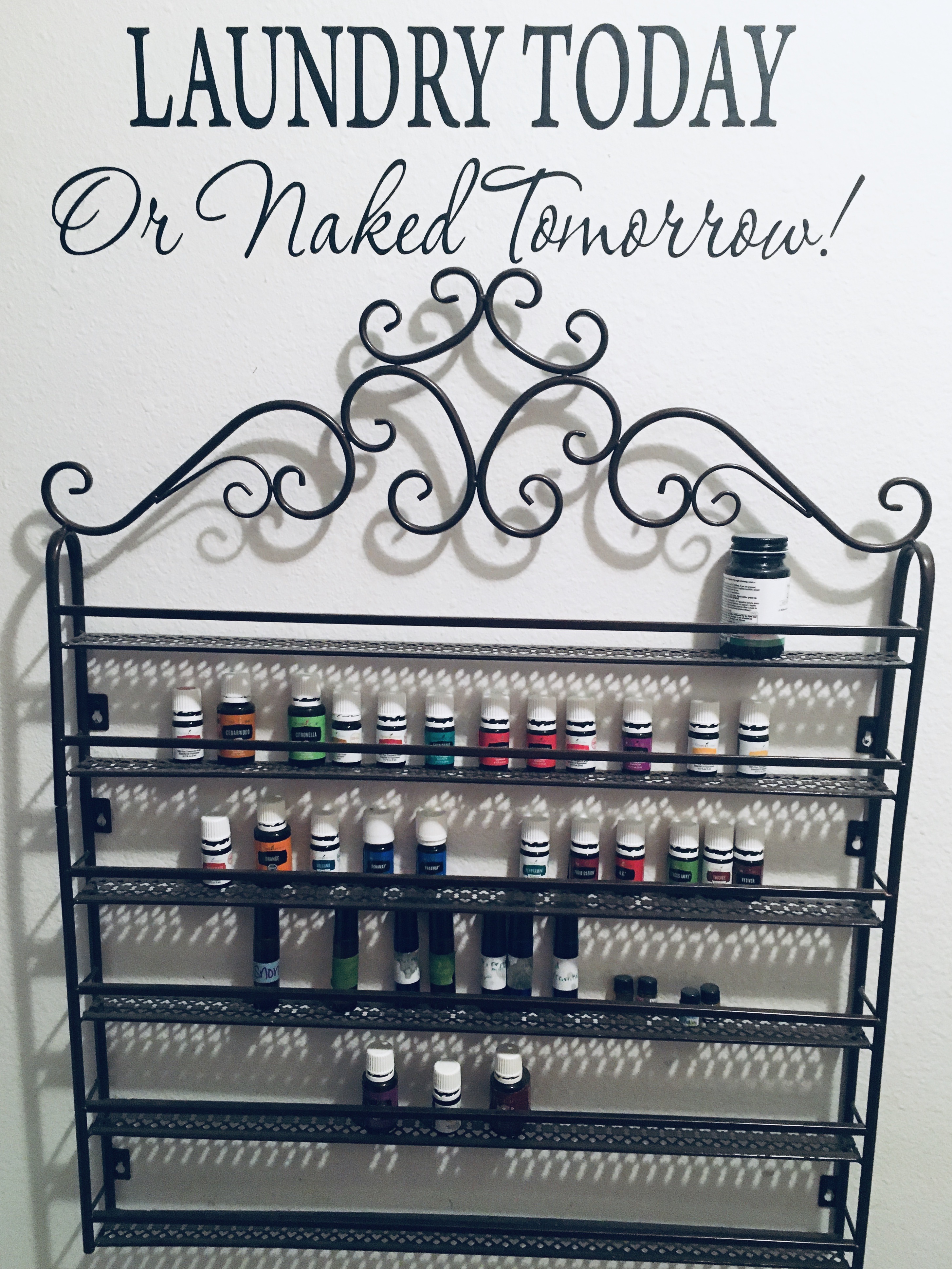
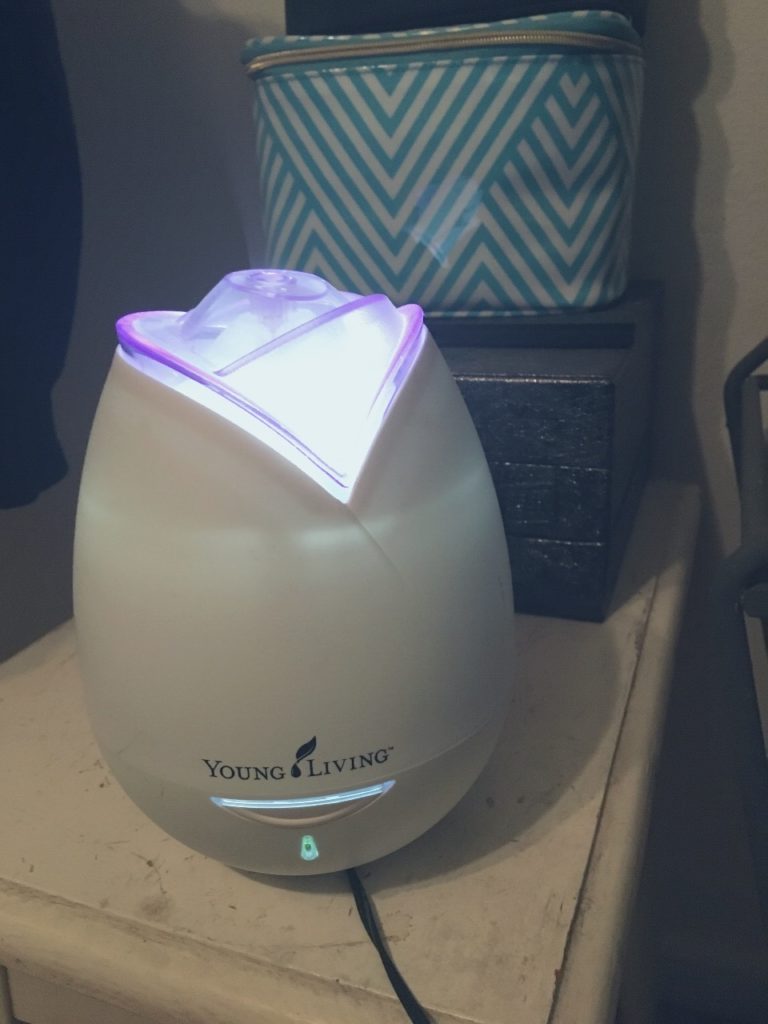

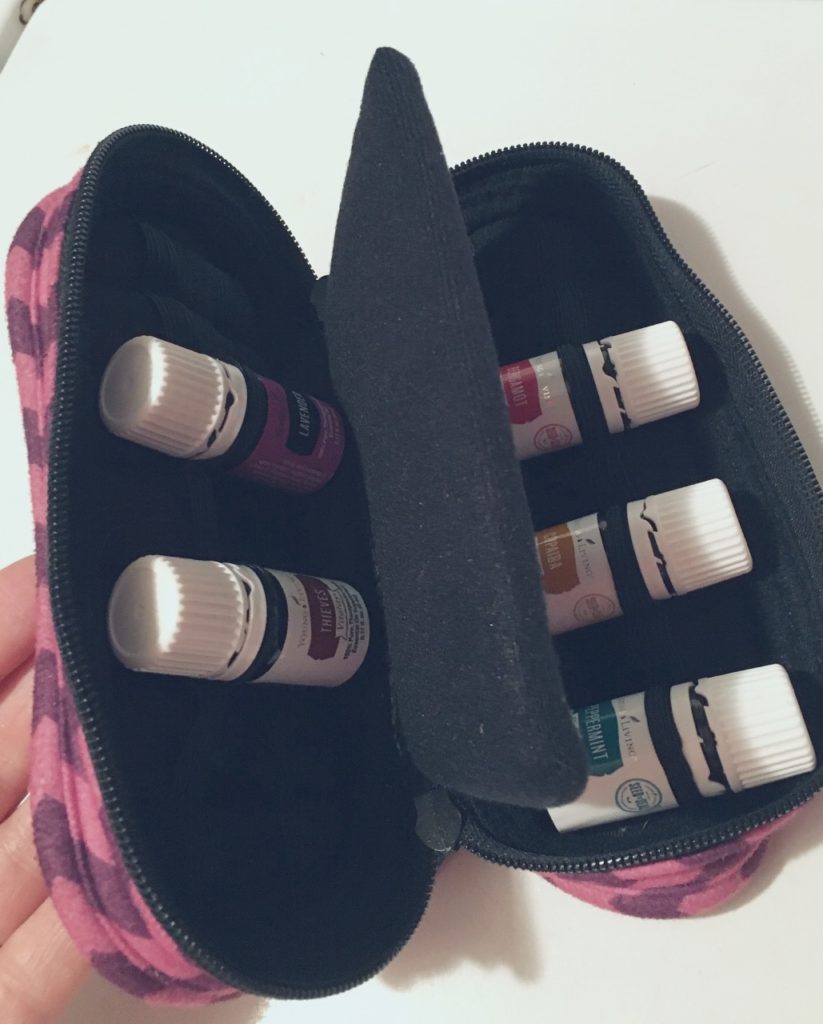



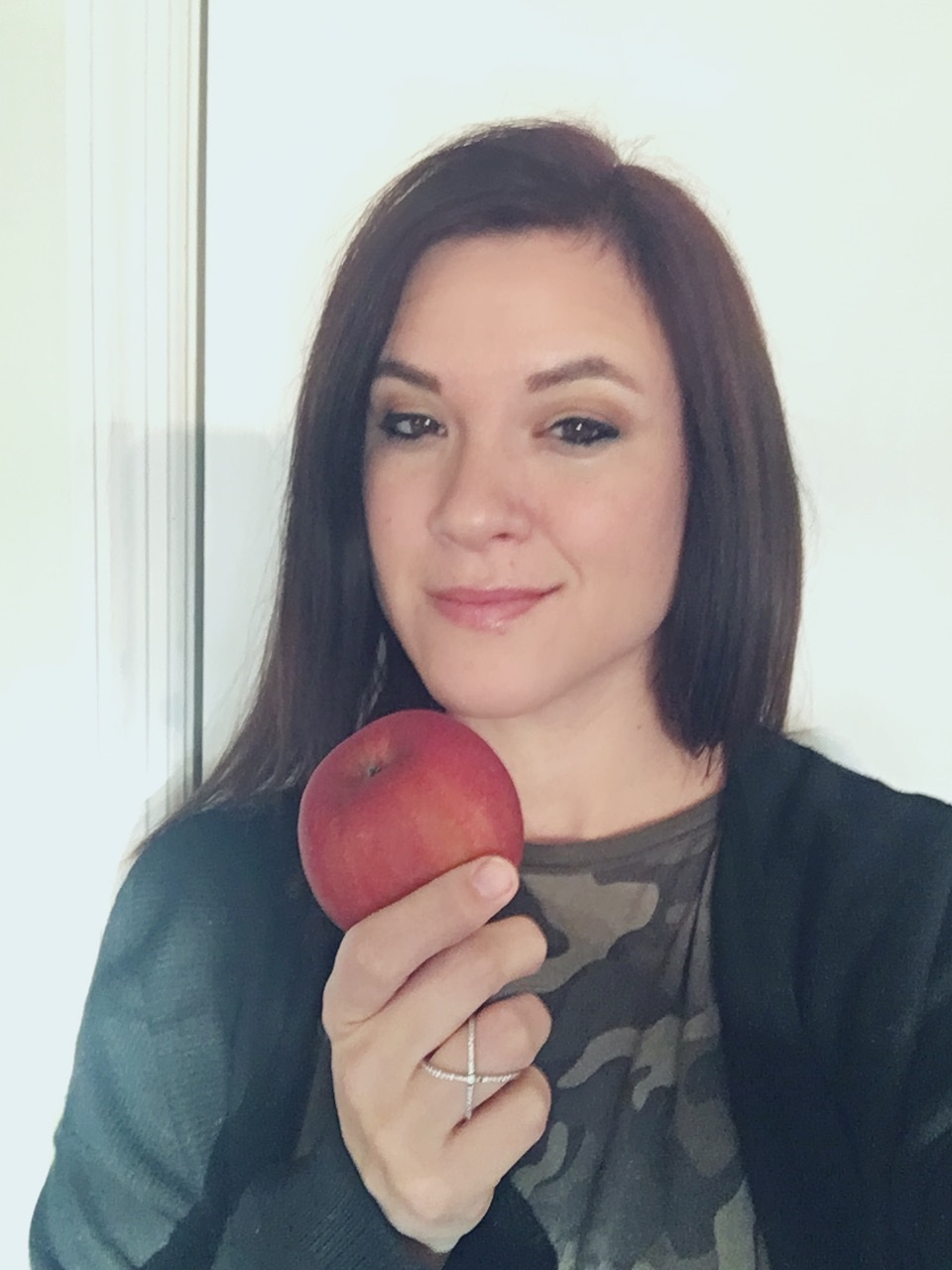




[…] My Top Essential Oils for Special Needs Recovering from Autism Recovery: What They Don’t Tell You About Early Intervention […]